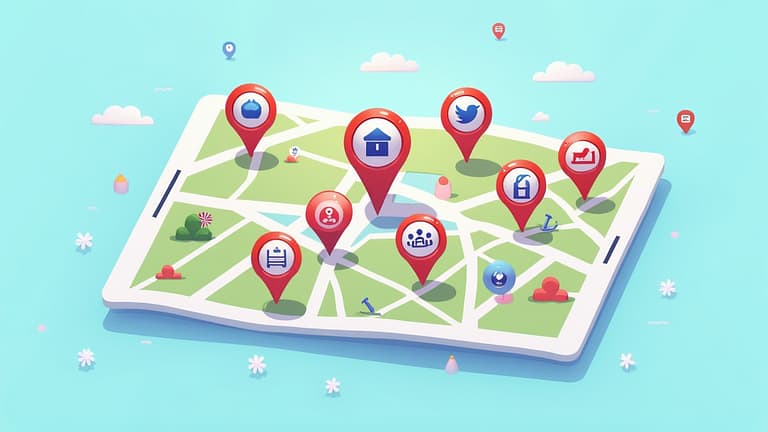
Local SEO Tips For Personal Websites
Personal websites are more than just online portfolios. They become a space to showcase your work, share your thoughts, and connect with a nearby audience. Local SEO helps you reach people in your area so that your website stands out in local searches.
When people search for services or personal content with a local focus, you want your website to appear among the top suggestions. With growing online competition, these local SEO tips can help you form genuine connections with your neighborhood audience while growing your personal brand.
This guide jumps into practical local SEO tips for personal websites. You will learn how to identify your audience, optimize local listings, create strong localized content, manage reviews, and more. By following these clear steps, you can improve your local search presence and make it easier for local visitors to find you.
Step 1: Identify Your Local Audience
Before boosting local traffic, know who your local audience is. Understanding the interests and needs of those in your community is the foundation of local SEO.
Key Questions
- What are the main demographics in your area?
- Which local groups might be interested in your content?
- What issues or topics in your community align with your website’s focus?
Insights to Consider
- People seeking local events or news.
- Community groups interested in local culture or hobbies.
With clear answers, you can tailor your content and SEO tactics to meet the expectations of local visitors.
Step 2: Boost Your Local Listings
Local listings play an important role in local SEO. Claiming and optimizing directory profiles, especially your Google My Business listing, makes your website easier to find in local searches.
Optimize Your Listings
- Claim your Google My Business listing and verify your contact details.
- Keep your website information consistent across major directories.
- Add photos and clear descriptions that represent your personal brand.
Google My Business Tips
- Ensure your listing shows your location, hours, and website URL.
- Ask satisfied readers or partners to leave positive feedback.
- Update your profile when your work or offerings change.
Optimized listings help search engines link your website to your area, boosting its visibility in location-based searches.
Step 3: Use Local Keywords Effectively
Selecting the right keywords is vital for SEO. For local targeting, focus on including your city, neighborhood, or region in your keywords. This tells search engines that your site is a good match for local queries.
Local Keyword Ideas
- Mention your city or community in your target keywords.
- Use phrases such as “personal website in [City Name]” or “local artist in [City Name].”
- Include keywords related to local events or culture relevant to your content.
How to Implement
- Incorporate local keywords into titles, meta descriptions, and subheadings naturally.
- Create location-specific landing pages for different areas if needed.
- Communicate in the language your local audience uses without overloading keywords.
Using local keywords correctly improves your chances of reaching visitors who are truly interested in what you offer.
Step 4: Create Localized Content
Develop content that truly speaks to your local audience. This means more than a passing mention of your area—it involves producing detailed content that offers real value to neighbors.
Content Ideas
- Write blog posts about local events, news, or community stories.
- Share reviews or recommendations for local businesses and venues.
- Create guides or resource lists for those interested in your local expertise.
Step up Your Local Content
- Include familiar landmarks or local references to make your content relatable.
- Collaborate with local creators to offer new perspectives.
Crafting localized content not only builds a connection with the community but also improves your website’s ranking for location-specific searches.
Step 5: Encourage and Manage Online Reviews
Online reviews are one of the strongest signals for local SEO, showing search engines that your website is trusted by local users.
Build a Good Reputation
- Ask local visitors or clients to leave reviews on Google My Business and other directories.
- Respond politely to reviews to build trust and strengthen relationships.
Handle Negative Reviews
- Address negative feedback calmly and offer workable solutions.
- Use criticism as a chance to improve your services.
With careful management, reviews can boost your local SEO and reassure potential visitors about your brand.
Step 6: Build Local Backlinks
Backlinks are links from other websites to yours. In local SEO, earning backlinks from neighborhood organizations or community sites is very important.
How to Earn Backlinks
- Team up with local bloggers or influencers.
- Write guest posts for community websites or local portals.
- Engage with local directories or organizations to get mentioned.
Backlink Tips
- Create quality content that local sites want to share.
- Attend neighborhood events and network with local groups.
Local backlinks signal to search engines that your website is a reliable source of local information, which can help improve your rankings.
Step 7: Monitor Your Performance and Adjust
SEO is an ongoing process. Regularly checking your website’s performance helps you see what works and what might need changing.
Track Your Success
- Use analytics tools to follow local traffic and visitor behavior.
- Monitor search rankings for your local keywords.
- Set up alerts for new reviews so you can respond quickly.
TweakYour Approach
- Try new local keywords and update your content as needed.
- Polish your Google My Business profile based on feedback and data.
By keeping a close eye on performance and making timely adjustments, you help ensure your local SEO efforts remain effective.
Common Questions & Troubleshooting
What if I have a small local audience?
Even a small local audience can grow with high-quality, local content. Focus on genuine engagement rather than a high number of visitors.
How long does it take to see results from local SEO?
Local SEO improvements can take several weeks or a few months to show clear results. Stay consistent and track changes to see what works best.
What should I do if I receive negative reviews?
Handle negative reviews with calm professionalism. Acknowledge issues, offer solutions, and use the feedback to make improvements.
Final Thoughts & Next Steps
Local SEO for personal websites is about connecting with your community and ensuring your unique perspective reaches those who appreciate it. By following these steps—knowing your audience, optimizing listings, using local keywords, creating relevant content, managing reviews, building backlinks, and monitoring performance—you set your website on a clear path to local success.
Your Action Plan:
- Identify your target audience and what they need.
- Claim and update your local listings, especially on Google My Business.
- Include local keywords naturally in your content.
- Create content that speaks directly to your community.
Thank you for reading and sharing!
What local SEO tip will boost your personal website the most? Share your thoughts and experiences in the comments below!
Ready to launch your online business the smart way?
Register your domain with Namegenuity
and connect it instantly
to Wealthy Affiliate’s powerful hosting platform.
No upsells, no tech headaches.
Just smooth, secure site setup
with everything you need in one place.
👉 Start building with Namegenuity + WA today.




